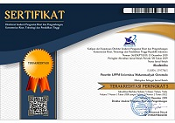PENGARUH PENAMBAHAN BAKTERI PROBIOTIK DAN SUMBER CARBON DALAM SISTEM BIOFLOK TERHADAP FCR IKAN NILA LARASATI (OREOCHROMIS SP.)
Abstract
Keywords
Full Text:
PDF (Bahasa Indonesia)References
Adelina. (2000). Pengaruh Kadar Protein dan Rasio Energi Protein Pakan Berbeda Terhadap Kinerja pertumbuhan Benih Ikan Bawal Air Tawar(Colossome macropomum). (Skripsi). Jurusan Perikanan. IPB. 39 hlm.
Affandi, R.and U.M. Tang. (2002). Fisiologi Hewan Air. Badan Penerbit Universitas Riau (unri Press), Pekanbaru. 217 hlm.
Asaduzzaman, M., M.A. Wahab, M.C.J. Verdegem, S. Huque, M.A. Salam, and M.E. Azim. (2008). C/N Ratio Control and Substrate Addition for PeriphytonDevelopment Jointly Enhance Freshwater Prawn (Macrobrachium rosenbergii)Production in Ponds. Aquaculture, 280: 117–123.
Avnimelech, Y. (1999). Carbon/Nitrogen Ratio as a Control Element in Aquaculture Systems. Aquaculture 176:227-235.
______ and G. Ritvo. (2003). Shrimp and Fish Pond Soils: Processes and Management. Aquaculture 220:549-567. http://dx.doi.org/10.1016/S0044-8486(02)00641-5
______. (2005). Tilapia Harvest Microbial Flocs in Active Suspension Research Pond. Glob. Aquac. Advocate. October 2005. 57-58 pp.
______. (2009). Biofloc Technology: A Practical Guide Book. World Aquaculture Society: Louisiana, USA. 120 p.
de Schryver, P., R. Crab, T. Defoirdt, N. Boon, and W. Verstraete. (2008). The Basics of Bio-Flocs Technology: The Added Value for Aquaculture. Aquaculture, 277: 125–137 pp.
FAO. (2014). The State of World Fisheries and Aquaculture 2006. FAO, Rome. 162 p.
Effendi, H. (1997). Biologi Perikanan. Yayasan Pustaka Nusatama: Yogyakarta. 163 hlm.
Hanafiah, K. A. (2005). Rancangan Percobaan. Raja Grafindo Persada. Jakarta. 223 hlm.
Haetami, K. (2007). Kebutuhan dan pola makan ikan jambal siam dari Berbagai tingkat pemberian energi protein Pakan dan pengaruhnya terhadap pertumbuhan Dan efisiensi. Laporan Penelitian. Fakultas Perikanan dan Ilmu Kelautan Universitas Padjadjaran. Bandung. 39 hlm.
Julie, E., D. Angela, S.H. Waluyo, T. Bachtiar, and E. Harris, (2014). The zise of biofloc determines the nutritional composition and the nitrogen recovery by aquaculture animals. Aquaculture, 426-427:105-111 pp.
Kusriningrum, R. (2008). Buku Ajar Perancangan Percobaan. Universitas. Airlangga. Surabaya. 38 hlm.
Schneider, O., V. Sereti, E.V. Eding, and J.A.J. Verreth. (2006). Molasses As C Source For Heterotropic Bacteria Production On Solid Fish Waste. Aquaculture 261: 1239- 1248.
Sedarmayanti dan S. Hidayat.(2002). Metodologi Penelitian. Bandung. Mandar Maju. 121 hlm.
Suhenda. (2005). Pertumbuhan benih ikan patin jambal yang diberi pakan dengan kadar protein berbeda. Berita Biologi Jurnal Ilmiah Nasional. 7(4): 191-197.
Article metrics
Refbacks
- There are currently no refbacks.
Copyright (c) 2018 Akademika : Jurnal Ilmiah Media Publikasi Ilmu Pengetahuan dan Teknologi
View My Stats © All rights reserved 2018, Akademika












